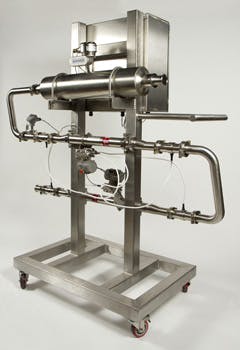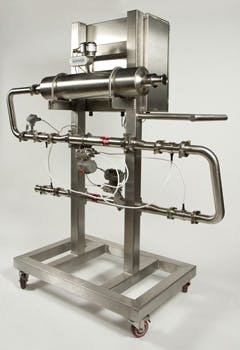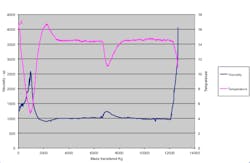In the food processing industry, manufacturers are looking for two things — taste and texture. Texture is the “feeling” in the mouth when the product is eaten, and it is usually assessed by measuring the product’s viscosity. In this area, companies are looking for consistency above all else. Quality control means ensuring consistent product texture. A successful process will generate a product that is always the same.
In reality, controlling texture is difficult and there are frequent fluctuations. Especially for non-Newtonian products, it is a real challenge to effectively measure viscosity in-line. Flowrate, temperature and flow history have an effect on viscosity, and managing viscosity of such products is not always an easy task.
Measuring Viscosity of Non-Newtonian Fluids Is TrickyIt has always been difficult to measure the viscosity of non-Newtonian fluids, because their viscosity depends on the precise flow conditions in effect during measurement. The same fluids flowing at two different flowrates in a pipe can give two different viscosity measurements.
To understand why this is, one must look at the microscopic level at the differences in how molecules are arranged depending upon the flow. For example, as the shear rate increases, the molecules tend to align themselves in the flow direction, with less resistance to flow. This molecular rearrangement can take some time to occur.
In some instances, the rearrangement time can be very short, compared to the observation time, but in other cases it can take much longer. In those cases, what happens to a fluid before the moment of measurement can have a considerable impact on the actual measurement.
Processes with non-Newtonian fluids passing through a pump, a filter, instruments with a smaller diameter than the pipe size, or those flowing through a sampling valve may be significantly affected. For example, a yogurt sample removed from a process pipe or through a sampling valve may take several minutes (or more) to stabilize, and only after this time can there be a stable and repeatable viscosity measurement on a laboratory rheometer.
The requirement to have the precise flow conditions in effect during measurement of viscosity is why the use of an in-line viscosity measurement device for measuring non-Newtonian fluids is so useful in process quality control.
Since direct measurement can be challenging, quality-control technicians have frequently had to infer viscosity from other measurements and simply hope for the best. Quality control labs are looking for ways to control viscosity more tightly so they can eliminate off-spec product. One method being used more frequently is a new type of in-line viscosity measurement device, which uses patented technology based on mixing principles applied to pipes. Bulk viscosity is measured on the whole fluid flow, which is re-homogenized by the action of in-line static mixers.
At a yogurt factory, the device was designed to control a smoothing valve on the white mass after maturation. The instrument is specially designed so the shear rate applied to the yogurt is not higher than that applied in the empty pipe, thereby creating a totally non-intrusive measuring process. Texture fluctuations have been reduced to a tenth of what they were, and protein consumption was optimized by reducing texture fluctuations and by attaining the minimal required specifications. The case study below offers more details.
Case Study: Yogurt Manufacturing Facility
Existing Quality Control Measurements Not Adequate to Ensure Consistency
For yogurt, viscosity measures whether the product is lumpy or smooth, watery, or too thick. A company may test a product and then adjust it to build the texture they want. But if not handled properly in the processing line — for example if the product is sheared too much — it will take much more energy and expensive raw materials to achieve the final desired texture. Also, the product’s texture can be broken and the manufacturer might experience huge variability. This happens during the curd change of phase, when the water and synerese (whey expelled during cooking) may break down. Operators may lack sufficient information to determine precisely how and why the variability came into the process and why it led to a product defect.
Take the example of a large yogurt factory that uses batch processing to mature its product. Once mature, operators empty the batch and pump the white mass to a packaging plant where it is cooled down before packaging. The high temperature is about 40 C in the tank, and it is cooled to about 20 C. Maturation stops when the product is cooled down. If it is too cool, the live enzyme will be killed and the quality of the product is affected, so maintaining the target temperature is extremely important.
Quality control personnel found that the quality of the white mass yogurt was not as stable as they expected, particularly after the maturation and cooling processes. Viscosity measures were done by sampling several production batches, and the results showed significant fluctuations, particularly between the beginning, the middle, and the end of a batch’s transfer process.
Data at the plant showed that the texture varied by plus or minus 25 percent for the same product produced in one month. QC personnel did not expect such a wide variation before actually measuring it, and it then became a serious concern.
The measurement method used involved taking a sample out of the line and bringing it to a laboratory to analyze. However, the very act of taking a sample out of the line affects the product. The product goes through the line in a pressure condition, so when passing through the sampling valve, the product is submitted to a shear rate that affects its texture. In addition, the time needed to get the product to the laboratory and conduct an analysis has an impact on the results.
The instrument generally used for the measurements is a viscometer, which measures under a particular operating condition. For products like yogurt, viscosity depends upon flow, and to measure you must define what flow condition you are using. Therefore, when you take a sample and make an analysis at the lab, you have to define viscosity at a particular flow condition. When you use a viscometer, flow conditions are not defined, so flow patterns will differ if there are two different fluids at the same operating conditions. They are not measurements you can compare. While an excellent device for measuring Newtonian fluids that flow in a pipe, like oil or sugar syrup, a viscometer does not work as well for yogurt.
At the yogurt facility, the target value is 1000 centipoise (CP), and the range of spec of the measurements went from 500 to 1500 CP. With such a wide range, quality control personnel are not able to really control a process using this measurement. Also, they can’t accurately replicate the measurements, which may vary by several hundred CP.
Analyses performed using two different offline instruments couldn’t give less than 10 percent difference between the two instruments.
In addition to the viscosity measurement, the analysis includes an instrument penetration test, in which a cylinder is pushed into the product with a given load and displacement is measured along with how fast the cylinder penetrates. This is done on the final product when it is packaged and could be conducted days after it is produced. A penetrometer measures the gel firmness of the final products. The measurement consists of measuring the load required for a cylindrical plunger to penetrate into the sample at a given speed. This measurement is usually accomplished about two days after the product has been packaged. This means that it takes at least two days before a lot can be validated.
A smoothing valve is sometimes used after the white mass has been cooled down to smooth the product, or break the protein aggregates that may occur. A smoothing valve is usually used at one setting for a whole batch transfer, based on offline measurements of previous batches. Operators found that a different setting would have been required for better optimization of this operation, especially at the beginning and at the end of a transfer.
Quality Control Group Seeks Better Information to Eliminate Inconsistencies
The quality control group at the yogurt plant was seeking more information and in-line measurements to understand the factors that generate defects and inconsistencies so they could avoid them. Rather than the off-line measurement process, they sought to continuously monitor viscosity during a batch transfer, after its cooling process, on a 3-inch diameter main production line. They installed a Viscoline CVL030S, made by KROHNE Inc. Viscoline is made with stainless steel construction, no moving parts, and no in-situ calibration required. It features continuous measurement with analog outputs. The unit is reliable, with a repeatability of 0.2 percent, resolution to 0.1 CP, while meeting government policy on metrological traceability.
KROHNE Inc.”s Viscoline CVL030S
With this device, the fluid flows through a continuous pipe containing two low-pressure drop static mixers. The sensor device measures the pressure drop at both static mixers by means of two differential-pressure measurements: ΔP1 and ΔP2. Pipe flowrate, required to accurately determine the flow regime to which the viscosity is to be calculated, can be obtained from either an external data measurement or with a flowmeter.
From the two pressure drop measurements and the flowrate reading, the fluid flow parameters are processed in the system, and the pipe line viscosity is determined. Every viscosity measurement is referred to a corresponding operating temperature. Thermal corrections can be applied, when a measurement is required at a reference temperature. Such correction requires laboratory characterization.
With Viscoline installed in the mainline, the smoothing valve can be opened or closed in an automated fashion to achieve constant viscosity in real time. Leveling the texture fluctuations, the recipe can be adjusted upfront to get closer to the minimum specifications required. This reduces the consumption of expensive ingredients like proteins and results in a consistent, stable, uniform product that costs less money.
In addition, with the Viscoline installed right after the cooler, operators observed that 10 percent of the product was out of specification for texture after the transfer. This was happening at every start and stop during a batch transfer, due to a lack of heat exchanger control during these transient operations. Prior to using the Viscoline, there had been no way to measure the effect of these transitions.The new device gave operators the means to better control their process, as well as measure the impact of their corrective actions. They can standardize operations with all the operators on the line. This is allowing them to save money and get a uniform product that meets their quality standards.
Look for Part II of this article, a case study that details how a beer manufacturer uses viscosity to separate yeast from beer, to be posted April 11, 2012.
Olivier Réglat is the VP of Technologies at Vionec Technologies. He has 12 years of field experience in process viscosity measurement with non-Newtonian fluids, and is one of the inventors of the Viscoline technology. Joe Incontri is the Director of Marketing, Americas, at KROHNE Inc. and has been with the company for 10 years.
www.krohne.com



